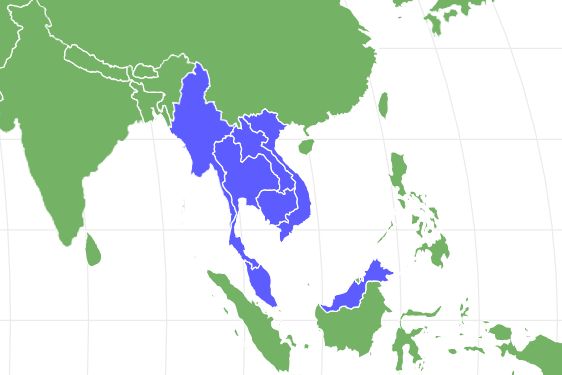Betta Fish (Siamese Fighting Fish)
Betta splendens
Can live in low-oxygen environments
Advertisement
Betta Fish (Siamese Fighting Fish) Scientific Classification
- Kingdom
- Animalia
- Phylum
- Chordata
- Class
- Actinopterygii
- Order
- Perciformes
- Family
- Osphronemidae
- Genus
- Betta
- Scientific Name
- Betta splendens
Read our Complete Guide to Classification of Animals.
Betta Fish (Siamese Fighting Fish) Conservation Status
Betta Fish (Siamese Fighting Fish) Facts
- Prey
- Zooplankton, small crustaceans, larvae
- Group Behavior
- Territorial
- Fun Fact
- Can live in low-oxygen environments
- Biggest Threat
- Habitat destruction, pollution, and cold temperatures
- Most Distinctive Feature
- Brilliant colors, aggressiveness, long tail fin
- Other Name(s)
- Betta or Betta splendens
- Optimum pH Level
- 6.9 - 7.2
- Habitat
- Marshes, flood plains, paddy fields
- Predators
- Larger fish, cats, newts, salamanders, birds, humans
- Diet
- Carnivore
- Favorite Food
- Insects
- Type
- Anabantoid
- Common Name
- Siamese Fighting Fish
- Number Of Species
- 73
- Average Clutch Size
- 30
- Slogan
- Can live in low-oxygen environments!
View all of the Betta Fish (Siamese Fighting Fish) images!
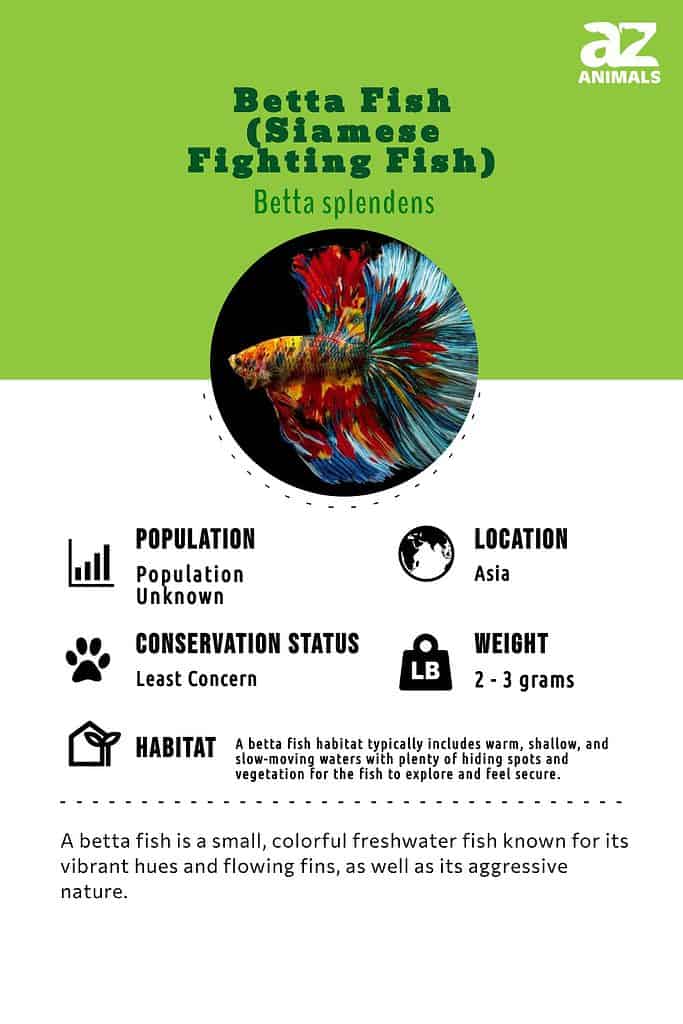
The Siamese fighting fish, also known as the betta fish, is second only to the goldfish in popularity as a home aquarium pet.
It is an aggressive, colorful fish that is native to Thailand, Vietnam, and Cambodia by way of the Mekong Delta. It is also present in Cambodia, Myanmar, Laos, Vietnam, and Malaysia and is a non-threatening invasive species in Australia, Brazil, Colombia, the Dominican Republic, Singapore, and the southeastern United States.
See all of our expert product reviews.
The active, solitary fish makes for a lively, exciting pet.
5 Incredible Betta Fish facts!
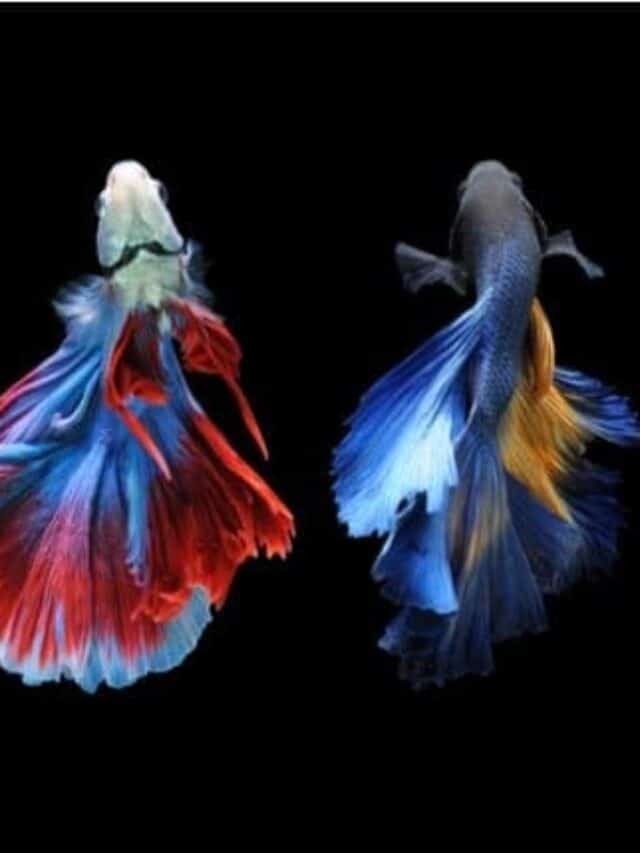
Although “betta” can refer to 72 other species of the Betta genus, it is used specifically for the species with the scientific name Betta splendens.
©Arif Supriyadi/Shutterstock.com
- Although “betta” can refer to 72 other species of the Betta genus, it is used specifically for the species with the scientific name Betta splendens.
- “Siamese fighting fish” refers to the Betta splendens species in order to avoid confusion with the other species of the genus.
- Both male and female bettas are aggressive, but the females are less intense and territorial.
- The betta’s highly aggressive nature is due to artificial selection, although it is aggressive in the wild.
- The fish spawn with the males building bubble nests, after which they protect the eggs and raise the young.
Classification and Scientific Name
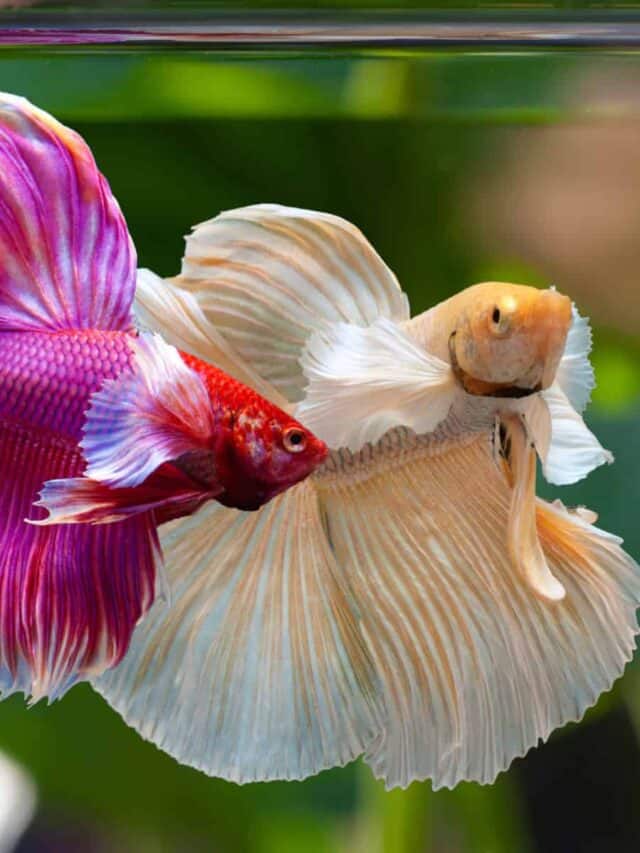
The scientific name of the Siamese fighting fish is Betta splendens.
©panpilai paipa/Shutterstock.com
Health and Entertainment for your Betta Fish (Siamese Fighting Fish)
See all of our expert product reviews.
The scientific name of the Siamese fighting fish is Betta splendens. It is one of 73 species of the Betta genus. Betta comes from the word “Bettah” meaning “an ancient clan of warriors.” All bettas are of the Osphronemidae family.
They are also Gourami, a term that includes the Helostomatidae and Anabantidae families. They are labyrinth fish, meaning they have a lung-like organ known as a labyrinth which they use to gulp air near the surface of the water and allows them to live in low-oxygen habitats.
Different Species
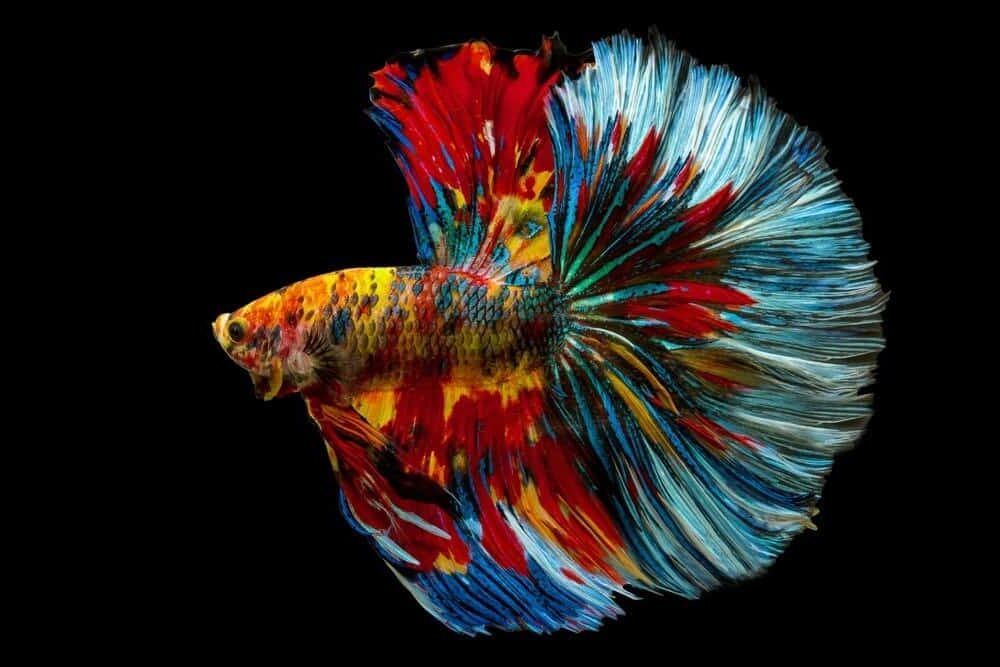
Curious to learn about the most aggressive freshwater fish for home aquariums? keep reading to learn about these unique fish!
©Mr. Witoon Boonchoo/Shutterstock.com
Although the Siamese fighting fish is the popular Betta species as a home aquarium pet, there are several other species that have a conservation status of Threatened.
Several Betta species have a Vulnerable conservation status according to the IUCN Red List. The species with the scientific name B. livida is Endangered, and B. miniopinna, B. persephone, and B. spilotogena are Critically Endangered.
Here is a full list of betta fish species:
- Veil Tail Betta
- Half Moon Betta
- Crown Tail Betta
- Double Tail Betta
- Plakat Betta
- Giant Betta
- Delta Tail Betta
- Super Delta Betta
- Half Sun Betta
- Rosetail Betta
- Feather Tail Betta
- Dumbo Ear Betta
- Over Half Moon Betta
- Koi Betta
- Marble Betta
- Copper Betta
- Mustard Gas Betta
- Butterfly Betta
- Dragon Scale Betta
- Samurai Betta
- Candy Betta
- Orchid Betta
- Galaxy Koi Betta
- Green Betta
- Lavender Betta
- Red Dragon Betta
- Salamander Betta
- Pink Betta
- Samurai Half Moon Betta
- Blue Mustard Betta
- Red Mosaic Betta
- Red Samurai Plakat Betta
- Purple Betta
- Red and White Betta
- Chocolate Betta
- Copper Marble Betta
- Orange Betta
- Black Orchid Betta
- White Platinum Betta
- Blue Samurai Betta
Evolution and Origins
Betta fish, also known as Siamese fighting fish, are known for their vibrant colors and aggressive behavior. These fish have become popular pets all around the world, but many people are not familiar with their evolution and origins.
The Betta fish belongs to the genus Betta, which is part of the family Osphronemidae. This family contains over 100 species of fish, which are mostly found in Southeast Asia. The Betta fish itself is native to Thailand, Cambodia, and Vietnam, where it inhabits shallow, slow-moving waters like rice paddies, swamps, and ponds.
The Betta fish’s evolution can be traced back to a common ancestor with the gourami fish, another popular fish in the Osphronemidae family. The Betta fish’s ancestors were likely small, dull-colored fish that lived in murky waters, which encouraged the development of their distinctive labyrinth organ. This organ allows Betta fish to breathe air from the surface, making it easier for them to survive in low-oxygen environments.
Over time, Betta fish evolved to become larger and more colorful, with longer fins and a more aggressive temperament. These traits helped them to attract mates and defend their territory in the shallow waters where they lived.
Appearance
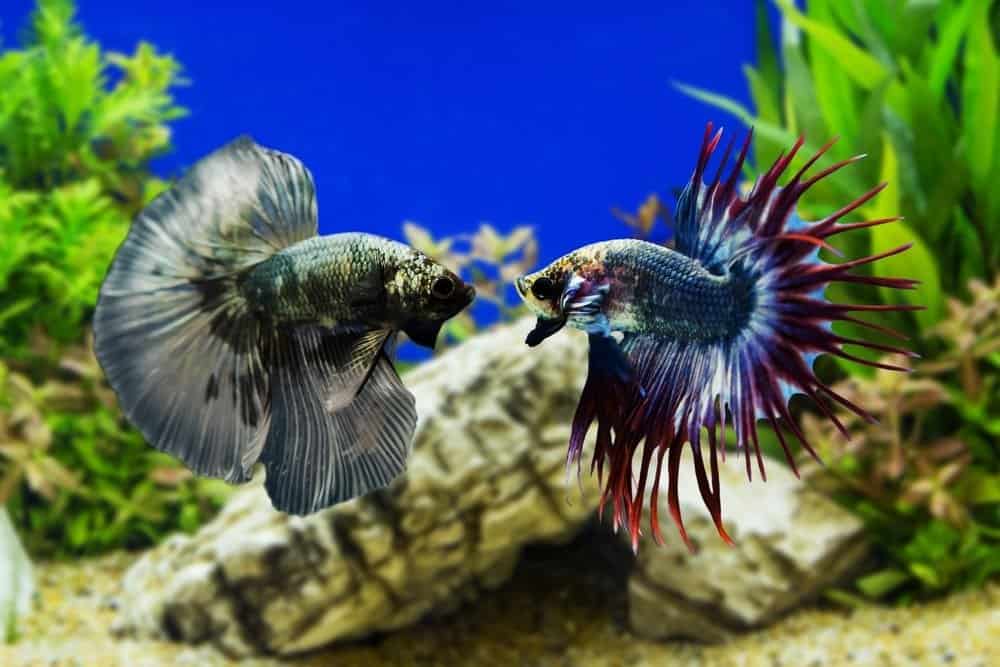
Siamese fighting fish are small fish that can have several possible colors.
©subin pumsom/Shutterstock.com
Siamese fighting fish are small fish that can have several possible colors. While dark blue and dark red are common colors, they may also be grey, black, red, orange, yellow, gold, blue, white, violet, or even multicolored. Each species is characterized by its tails, and the betta has a typically long tail fin.
Additionally, there are differences in appearance between wild and captive bettas, with the main difference between the shape of their fins and their colors. Those in captivity have brighter colors, although both display brighter colors when feeling threatened.
All have torpedo-shaped bodies with upturned mouths that they use to eat from the water’s surface.
Fish Distribution, Population, and Habitat
Siamese fighting fish are native to the Mekong Delta and are most populous in the Chao Phraya River. Their population size is unknown, but it has been observed to be uncommon given its range of habitat.
It is an invasive species in Singapore, Australia, Brazil, Colombia, the Dominican Republic, Guam Saipan, Puerto Rico and the Virgin Islands, Hawaii, Alaska, Connecticut, Texas, and Florida, but it is not disruptive to the natural ecosystems according to the U.S. Fish and Wildlife Service.
Habitat destruction, pollution, cold temperatures, and predators have decreased its population in the wild. While in captivity, proper care involves keeping them at a warm freshwater tropical temperature of 74-80 degrees Fahrenheit.
All betta species are anabantoids, meaning they use a unique organ called a labyrinth to breathe in low-oxygen environments such as large puddles, drainage ditches, rice paddies, and slow-moving streams. The labyrinth organ is lung-like and allows them to breathe directly from the air.
Predators and Prey
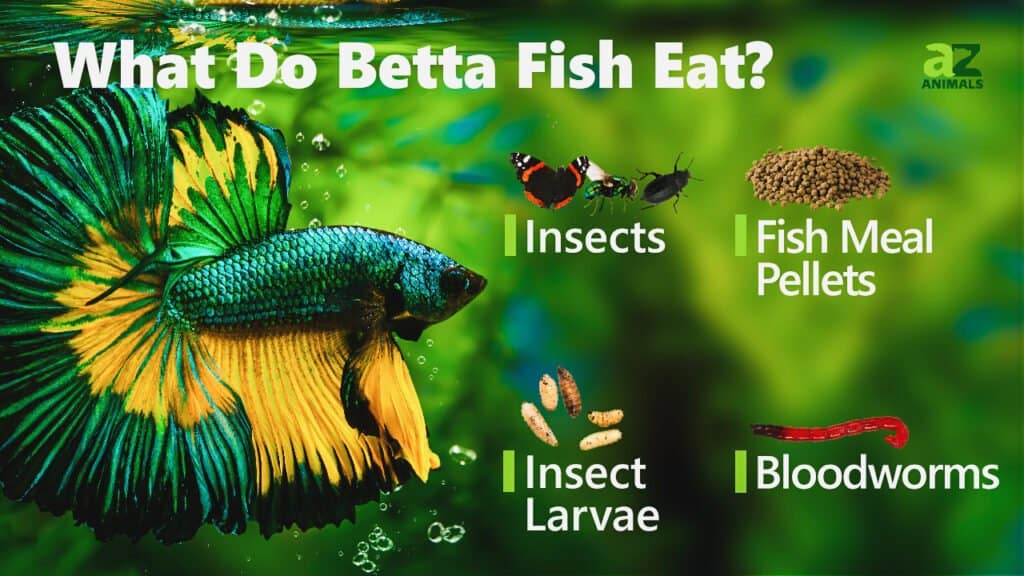
Bettas are carnivorous and consume zooplankton, brine shrimp, daphnia, and other small crustaceans, bloodworms, and the larvae of aquatic insects, including that mosquitos. The two biggest threats to wild bettas are habitat destruction and pollution.
Its predators are larger fish, cats, newts, salamanders, and birds. Humans also reduce their numbers in the wild by capturing them to house them in captivity as pets or for fighting competitions with other males. They have been bred specifically for aggression in Thailand.
Reproduction and Lifespan
Bettas reproduce through spawning, starting with a mating dance in which the male and female spiral around each other. The male builds a bubble nest and proceeds to guard the eggs as well as raise the young. Gestation is 24-36 hours and the young stay in the nest until their bodies absorb their yolk sacs. The typical lifespan of the betta is 3-5 years with proper care.
Fishing and Cooking
Siamese fighting fish are too small to be eaten, although large Gourami fish with the scientific name Osphronemus goramy are eaten in southeast Asian countries and Sundanese cuisine.
Population
The betta’s conservation status in the wild is Vulnerable as a result of its declining population and the possibility of becoming endangered without conservation efforts.
Do Siamese Fighting Fish (Betta Fish) Make Good Pets?
Betta fish are popular pets thanks to their incredible colorations. Betta fish grow to be 2.5 inches long on average and require a tank that’s 5 gallons in size. Betta fish can live for 6 years in captivity, so if you’re getting one, be prepared to care for it for years to come!
Betta fish make good pets but also benefit from toys or entertainment as well as tanks kept at around 80 degrees Fahrenheit. If you provide a Betta with these conditions, it should live a long and healthy life.
View all 285 animals that start with BBetta Fish (Siamese Fighting Fish) FAQs (Frequently Asked Questions)
What do Siamese fighting fish eat?
Aquatic insects, insect larvae, bloodworms, daphnia, and brine shrimp.
How long do Siamese fighting fish live?
Their lifespan is 3-5 years, although there have been rare cases of them living 7-10 years.
Where do Siamese fighting fish come from?
Thailand.
Why did my Siamese fighting fish die?
Siamese fighting fish can get swim bladder disease due to bacterial infection or parasitic worms, which can be fatal.
What fish can be kept with a Siamese fighter?
Platies, neon tetras, and Cory catfish. Care should be taken when housing betta males with females.
What Kingdom do Siamese Fighting Fish belong to?
Siamese Fighting Fish belong to the Kingdom Animalia.
What phylum do Siamese Fighting Fish belong to?
Siamese Fighting Fish belong to the phylum Chordata.
What class do Siamese Fighting Fish belong to?
Siamese Fighting Fish belong to the class Actinopterygii.
What family do Siamese Fighting Fish belong to?
Siamese Fighting Fish belong to the family Osphronemidae.
What order do Siamese Fighting Fish belong to?
Siamese Fighting Fish belong to the order Perciformes.
What genus do Siamese Fighting Fish belong to?
Siamese Fighting Fish belong to the genus Betta.
What type of covering do Siamese Fighting Fish have?
Siamese Fighting Fish are covered in Scales.
In what type of habitat do Siamese Fighting Fish live?
Siamese Fighting Fish live in marshes, floodplains, paddy fields.
What are some predators of Siamese Fighting Fish?
Predators of Siamese Fighting Fish include larger fish, cats, newts, salamanders, birds, and humans.
What is the average clutch size of a Siamese Fighting Fish?
Siamese Fighting Fish typically lay 30 eggs.
What is an interesting fact about Siamese Fighting Fish?
Siamese Fighting Fish can live in low-oxygen environments!
What is the scientific name for the Siamese Fighting Fish?
The scientific name for the Siamese Fighting Fish is Betta splendens.
What is a distinguishing feature of the Siamese Fighting Fish?
Siamese Fighting Fish have brilliant coloration and a long tail fin.
How many species of Siamese Fighting Fish are there?
There are 73 species of Siamese Fighting Fish.
What is the biggest threat to the Siamese Fighting Fish?
The biggest threats to the Siamese Fighting Fish are habitat destruction, pollution, and cold temperatures.
What is the optimal pH for a Siamese Fighting Fish?
The optimal pH for a Siamese Fighting Fish is between 6.9 and 7.2.
What is another name for the Siamese Fighting Fish?
The Siamese Fighting Fish is also called the betta or betta splendens.
How do Siamese Fighting Fish have babies?
Siamese Fighting Fish lay eggs.
What are the differences between a guppy and a betta fish?
The key differences between betta fish and guppy include size, reproduction, respiration, behavior, origin, and appearance.
What is the difference between a male betta fish and a female betta fish?
One major physical difference between the male and female betta fish is the length of their fins. The males have noticeably longer fins than their female counterparts, and in some species, male fins are four times longer than the females’.
Thank you for reading! Have some feedback for us? Contact the AZ Animals editorial team.
Sources
- Wikipedia, Available here: https://en.wikipedia.org/wiki/Siamese_fighting_fish
- Fishkeeping World, Available here: https://www.fishkeepingworld.com/types-of-betta-fish/
- Fishbase, Available here: https://www.fishbase.se/summary/Betta-splendens.html
- The Aquarium Advisor, Available here: https://theaquariumadviser.com/siamese-fighting-fish-care/
- Betta Care Fish Guide, Available here: https://www.bettacarefishguide.com/swim-bladder-disease-in-bettas/
- Aquarium Fish City, Available here: https://aquariumfishcity.com/freshwater/labyrinth/betta/
- Fisharoma, Available here: https://fisharoma.com/siamese-fighting-fish-betta/
- USGS, Available here: https://nas.er.usgs.gov/queries/FactSheet.aspx?SpeciesID=326

